As subtle as a rocket-propelled grenade and probably just as likely to explode on us, the totally bonkers Cagiva WMX500DE Desert Enduro was always going to be a wild ride…
Al-Cagiva and its Axles of Evil
Can an inanimate object be evil? Can it possess a personality or simply be ‘possessed’? Of course not, that’s just plain daft. I’ll tell you what else is daft: strapping a fuel tank the size of a space hopper to a half-litre two-stroke and selling it to the general public. Because they’ll likely find it such a handful that they’ll declare that it is indeed EVIL – not a particularly good trait if you’re hoping to shift new models but a hilarious characteristic to have in a magazine project bike..!
The longest running project bike in TBM history is just such a machine – a 1986 Cagiva WMX500 Desert Enduro. Last shown in the mag in July 2004 (TBM 107), until last month we ourselves hadn’t seen the thing for a good few years. So where’s it been all this time? Has our old Cagiva been holed-up in the Tora Bora caves, plotting the demise of the Western dirtbike world, or have less sinister forces been at work. Allow me to fill you in on the whole terrifying saga…
Red Alert
Way back in issue 89, a classified ad for this fearsome motorcycle arrived here at TBM HQ. ‘Hmm, that sounds interesting’, I thought, and the seed of a feature was sown. ‘Buying Power’ we called it (which ran in TBM 90), all about getting hold of potent dirtbikes for very little money.
Having contacted the seller – a chap by the name of Paul Lewis who I seem to remember was bizarrely (or perhaps ‘heroically’) using the WMX to commute on – we persuaded him to let us ride the bike for the feature. Incidentally, we also brought along a couple of other machines ‘borrowed’ from the classifieds. Si chose a Gilera RC600 (essentially a Nordwest with knobblies) and TBM columnist at the time Mark Williams a TT500 (an American market XT500 without lights), but in terms of bhp-per-pound (in both weight and financial terms), neither could hold a candle to the raucous Cagiva.
At this point we had no intention of doing anything other than taking a blast on it and snapping some pics for the feature. But having blatted up and down a Hampshire beach enjoying the ludicrous grunt that can only come from an open class two-stroke whilst carpet-bombing everything behind the bike with fist-sized pebbles, I casually remarked to Si that the big-tanked 500 two-stroke would be hilarious to ride on the fast fireroads and open moorland of the Cambrian Rally – probably the closest you’d get to a desert race on this sceptred isle. The only problem was that the organisers, the Welsh Trail Riders Association (WTRA), had banned all two-strokes except those they considered to be ‘trailies, a list of which was sent out with each set of regs.
Back at the office I dug-out some Cambrian paperwork and would you believe it, there in black ‘n’ white alongside such obvious green lane fodder as Honda’s CRM and the DT230 Lanza, were the words ‘Cagiva WMX500DE’. No way, well knock me down with an RPG..!
Now by this point I’m guessing that you’ve worked out that the Cagiva definitely isn’t a trail bike. No sirree, Bob, not one bit. It DOES have lights and a speedo but there’s more to a ‘trailie’ than the vague vestiges of road legality. The DE is essentially a mid-‘80s MXer with a wide-ratio gearbox and a monster fuel tank, designed to blat flat-out across the scrubby deserts of the southern States. How it appeared on WTRA’s list is as big a mystery as how someone thought a Cagiva Raptor is a trail bike! (Curiously the TL1000-motor’d streetbike was also on there…)
Having high-tailed it back down to the south-coast a few twenties short of the £600 asking price (both literally and metaphorically), the Cagiva was brought back to HQ and the procrastination began in earnest. Rather than ride the bike as-is, we intended to turn it into something of a project, as our brief test-ride had revealed a handful of areas requiring attention, not least the ineffectual front brake. And with the Cambrian a few short months away we figured it best to set our sights for the following year…
So instead that year we entered the rally on a beautifully restored Montesa 250 H6 – a wonderful little mid-‘70s two-stroke trailie that didn’t appear on ‘The List’ but was so pretty that no-one could possibly object to its entry. Meanwhile the Cagiva was intermittently wheeled out of the shed to be worked on. The shock was sent off to be rebuilt; a new front caliper was acquired; and various other odds ‘n’ ends were procured. It wasn’t intended to be a full concours nut ‘n’ bolt rebuild – far from it – just enough to get us around a few laps of the Eppynt ranges without mechanical mishap, on a bike that looked a smidgen smarter than when we bought it.
Then it happened. Ahead of the 2004 Cambrian the organisers decided to ban ALL two-strokes. We were apoplectic. Here was an event aimed at trail bikes, one which had long-since banned 2T competition machines yet had been infiltrated by hundreds of modern four-stroke enduro bikes, and they’d further reduced the number of trailies eligible for entry. Plus, of course, they’d scuppered our ride and our feature on what was (we readily admit) a blatant ringer…
Naturally we weren’t very complementary about the organisers’ decision in the following instalment of our build report. ‘They haven’t moved the goalposts. They’ve pulled them down, chopped them into little bits and chucked them on the bonfire, whilst dancing round in circles chanting in that funny language of theirs, before spiking their football on the park fence as they left’, was how I described their move back in ‘04. Yet despite a literary haranguing they still didn’t back down. I can’t think why…
Anyway, we ended the piece saying that we’d simply have to find another event to enter. But what? ‘Evo’ or ‘vintage’ enduros were pretty thin on the ground back then and besides, the whole idea was that the WMX was sneaking into a class where it clearly didn’t belong and where we’d have a giggle blowing Pamperas and DTs clean off the hillsides as we blasted past!
Progress ground to a halt. The bike was still in running order, albeit part-disassembled, but without an event to aim for the project lost purpose and we began using its big tank as a bowser to hold old stale fuel…
Salvation came in the form of TBM reader and enduroist, Liam Humberstone. As you’ll have read in the dirtbike-engined car feature from TBM 205, Liam’s the course leader on the Motor Sport Engineering degree at the University of Central Lancashire and wondered if he could take temporary custody of the Cagiva as a project for his students (presumably as a lesson in how not to design a sensible, reliable dirtbike!).
Liam drove down from Preston to TBM Towers, we swept all of the Cagiva parts into a box, and everything was bundled into his van. That was seven years ago. Since then we’ve kept in sporadic contact, wondering how the students were finding working on an Eighties dirtbike with little spares back-up. And things seemed to be progressing nicely – their ingenuity came to the fore and there was even talk of one of them entering Weston on the 500. But, fortunately for all concerned, that never happened. (We’d resisted using the Cagiva for the beachrace as it wasn’t so long since we entered aboard another daft open-class stroker, the Yamaha IT490…)
And that brings us more or less to the present day. A renewed interest in all things ‘classic’ coincided with the university workshops being refurbed and them needing the space, so it worked out well for both parties if the Cagiva returned to west London.
Bomb Squad
Seven years held hostage at a training camp in the barren wastelands of The North had done the Cagiva the power of good. The work the UCLAN students (Brennan Williams and Matt Dixon mainly) had carried out meant that you’d never guess it’d been chained to a workbench for 2555 days, only ever seeing daylight filtered through small, barred, windows or when accompanied into the confines of the workshop yard. Or maybe you would…
We hadn’t wanted to radically alter the Cagiva, nor dress it in modern clothes, and the uni had stayed true to this ethos. The WMX looked like an ‘80s dirtbike with a few modern additions.
However, let’s start with the heart of the beast, that lovely 500cc two-stroke lump. During its time Oop North it received a full rebuild. As far as I can remember there wasn’t too much wrong with it, after all it started (eventually) and ran okay (ish). But where’s the harm in freshening-up a 26-year-old engine of unknown provenance, eh?
So it was taken from the frame and the cases were treated to a chemical clean. Back in the day the 500s were renowned for sending their kickstart shafts smashing through the cases when they violently kicked back (perhaps they should’ve called it the WMX500 IED..?) and at some time in its life our bike had done just that. Where the cases had been rewelded they’d warped with the heat, so they were milled flat in order to ensure everything lined up okay and remained oil-tight.
The barrel was rebored and down it slipped a fresh piston. Where d’ya get a new slug for a relatively rare, open class, ‘80s Italian dirtbike? You don’t. You use one designed for an old YZ490! Liam described its fitment as ‘a cross between engine building and gynaecology’, as the Yamaha piston runs a very short gudgeon pin with the circlips sitting deep inside, requiring a huge degree of manual dexterity and a great deal of care and patience to get everything neatly in place.
The cooling system demaded some attention, mainly because the original hoses were as perished as a nun’s prophylactic stash. Back in 2005 we’d bought some New Old Stock (NOS) replacements from Husky Sport (as it was they who originally imported the small number of WMX-DEs in the UK) but as they’d sat on the shelves and in our workshop for many years, they weren’t up to much. Rather than risk them failing, one of the students ordered some new silicon hoses, and one of the rads was welded as it had almost corroded through.
When we bought the bike the exhaust consisted of the lovely original snaking expansion chamber and a very unoriginal and Unlovely ‘silencer’, which produced an aural assault akin to a Stinger rocket attack on a Jedward concert. It looked crap too, so quite why it was fitted we’re not sure. The original ‘Cagiva’ stamped part came with the bike, so we can only imagine that this was even louder. Yikes!
Brennan spent an entire evening beating out plates of Dural alloy with which to build a new end-can, and this was based around an old KTM design. The end result is much prettier, and far quieter, than the old Suzuki silencer that’d been cobbled onto the end of the pipework, and comes with the added benefit of being rebuildable. Top work…
Up front the spindly forks were showing signs of wear on their unprotected chromework, and with the seals perished and hardened the best option was a complete rebuild and rechrome. They were in good hands with James Baker, who subsequently went on to work as a technician with the Buildbase BMW BSB squad. Doubtless his work on the Cagiva stood him in good stead…
Security Clearance
We’d supplied the uni with a brand new (OE) Brembo caliper to replace the manky original, though rather than match this to the replacement master cylinder we’d also sourced, Liam instead fitted one he had kicking around the workshop from a recent KTM 250EXC-F. Given that the lever on the original master cylinder is a six-inch long sliver of monkey metal this is no bad thing, and the lever pressure is greatly enhanced. We weren’t expecting too much from such an old design of disc/caliper, but frankly any form of retardation will be an improvement on what went before!
The new master cylinder was mounted on the unbranded braced bars we’d sent up with the bike, which now also wear new grips, a black barpad, the original switchgear, and the OEM clutch lever with a new Venhill cable.
We’d given the university a quick-action throttle for the 500 (we thought it’d be a giggle), and it took Liam an evening of fettling to get it working smoothly. We haven’t delved into its workings to see exactly what’s gone on, but given the fact that it rotates just as far as a regular throttle we suspect it’s set on the ‘enduro’ option rather than ‘MX’. Probably no bad thing…
The broken ‘n’ bodged rear brake lever had already been replaced with a New Old Stock part obtained from Husky Sport, but we hadn’t taken a look at the state of the rear shoes lurking within the drum. These were shot, and so new pattern replacements were fitted.
On the other side of the rear-end, a new chain and sprockets were slipped into place, and the students removed the upper chainguard and launched it into the scrap metal bin, before replacing it with a far smarter alloy item they fabricated themselves. Strictly speaking, without pillion pegs the bike doesn’t need the guard, and indeed they came from the factory without one. But it’s not doing any harm…
When it came to the bodywork there wasn’t a great deal that could be done without completely changing the look and charm of the bike. The original radshrouds remained, as did the battered old sidepanels as replacing these would’ve required some serious effort. We’d already sourced a road legal headlight, a pair of slightly more modern fenders and an LED tail-light, though only the front mudguard had been fitted… which the students ripped off and slung in the bin!
You see, when it came to mounting the front fender we found that there’s not much clearance between the bottom yoke and the rads, and the new fender wouldn’t fit. So we trimmed some plastic from its back edge. Still it fouled the rads. So we trimmed a bit more. Nope, that didn’t work either. More and more red plastic fluttered to the floor until finally we could turn the bars… It did look a little stubby back there, mind you!
Despite the rads being covered with sturdy metal mesh (as standard) Matt decreed that our ‘shorty’ fender was largely ineffectual and it was only a matter of time before a stone punched straight through a radiator like an armour-piercing shell. So the original Cagiva part was given a good clean and refitted…
At some point our bike had lost its original rear fender (with the lovely rally-style triangular tail-light) only to be fitted with a drooping universal part that’d turned pink with age. We’ve seen replacements crop-up on the web from time-to-time, and it wouldn’t have been TOO hard to fit the more common MX mudguard and slap on a new light. Far easier, however, was getting hold of a slightly more modern universal fender and an LED tail-light with numberplate hanger.
With the new rear fender bolted on and the lights in situ the Cagiva still looks like a 1980s desert racer and it’s now in a far better state than it left us all those years ago. How does it perform? Well, let’s find out, shall we?
Counter Attack
‘You might want to check the jetting’ were Liam’s parting words when we collected the bike, and with that in mind we figured a good blast across some open stubble fields would give us the perfect opportunity to ‘plug chop’ the beast. However, before we could even think about that, there was the small matter of getting the thing started…
Whilst wheeling it out of the TBM lock-up ready to load into the van for the trip to our test track, Si suddenly appeared wearing what looked to be every piece of body armour he’d ever owned. He looked like a stunt double from The Hurt Locker. He turned and made ‘The Long Walk’ towards the bike. Everyone else cowered behind the yard wall. Tentatively, he turned on the fuel. The device was armed. Swinging the kickstart out away from the side of the engine, he rested the sole of his boot on it and pushed down until it came up against the compression. Time seemed to slow. There was a pause, maybe for a deep breath or a final prayer, before he gave the kicker an almighty hoof. Nothing…
Easing that big piston to the top of the barrel he gave it another try. There was a bit of a fizz and a puff of smoke but nothing more. Maybe it’s a dud..?
As the kicking continued those watching gradually crept out from behind the wall to offer a helping hand. The effort of booting the big motor over, not to mention the pressure of straddling a UXB, got to Si and he began to strip off all of protective gear. Wiping his brow on his shirt sleeve, he suggested that a bump-start might be in order, but that London was probably not the best place for it.
The bike was loaded into the van and then off-loaded at our secret test track in the Home Counties, pushed to the top of a nearby hill, before being pushed down. Si snicked her into third gear before dumping the clutch and bouncing down on to the seat. Still nothing. Clearly it wasn’t going to…… ‘Kerrrrboooom!’
The Cagiva suddenly exploded into life, the big piston whizzing up the barrel like a live mortar round, sending plumes of oily blue smoke high into the air. Would it idle? Who cared! Keeping it running was the most important thing now; getting some heat in it so that it’d be easy to restart. Si made off across the field, the bike running sweeter with every passing second as the motor worked its way up to temperature.
Swinging the bike round in a wide arc, he prepared for a run back past our makeshift base. Second; third; fourth: each slotted home and gave the red missile increased velocity. But the Cagiva was waiting for fifth gear before launching its attack, waiting for maximum impact…
A gentle vibration in the brake pedal was the only warning it gave before launching its attack and hitting the self-destruct button. ‘P-tang!’ The rear brake assembly ripped from its mountings, firing exotic Italian shrapnel in all directions. The assembled onlookers dived for cover.
While Si’s brain was trying to process what was happening to the rear brake, the Cagiva surreptitiously launched phase two of its assault and silently wound out its lockstops. The steering was rendered out of action…
Set on a collision course with the TBM van, the only chance of avoiding a greater catastrophe was relying on the (previously ineffectual and largely untested) front brake. Everyone braced for impact.
But it wasn’t forthcoming. The Cagiva’s dastardly plan had been thwarted and disaster narrowly averted thanks to that fresh front caliper and Liam’s foresight in fitting a modern master cylinder. Si stopped just short of the van, our makeshift base and refuelling depot…
The killswitch brought a welcome silence and the cleanup process began. Combing the field saw the brake parts gathered together and put safely to one side, meanwhile the WMX was stripped of its deadly lockstops and ridden for a few more laps to properly test the motor (all good. Really good!). Then it was thrown unceremoniously into the van, whereupon it was spirited away to an undisclosed location to await its fate in a windowless cell.
Terrorist Sell
So what next for the 500? Well WTRA’s ruling on two-strokes changed the whole focus of our WMX project, besides which the Cambrian has now morphed into a big bike rally with no real place for our Cagiva. We could use the bike for ‘vinduro’ type events (in the pre ’85 class), but we don’t really have the time – nor the space in the TBM workshop – for another little-used ‘classic’ requiring work. Personally I reckon it’s just the tool for JK or Alex to try their hand at a Long Distance Trial but they seem to be wise to any underhanded efforts to send them to their doom…
And so it’s with great regret that the mighty WMX500DE is up for sale. As yet we haven’t ‘interrogated’ the bike about the back brake so we’ve no idea what went wrong with it, but aside from that it’s near enough race-ready (but not road legal), and comes fully rebuilt with a handful of spares plus reams of paperwork, including a full parts manual. The price? Well it’s a rare and appreciating classic (honest guv’nor), and with the vintage enduro scene gathering momentum it’s surely got to be worth £1000.
Prepared to take on the Axles of Evil? You can contact us via the editorial number in the front of the mag. Just don’t mention the phrase Al-Cagiva when you call. There’s a strange unmarked van parked across the road from our office and I’m sure GCHQ are tapping our phones…
Thanks to: Liam Humberstone and all those at UCLAN who helped resurrect the Cagiva WMX500DE. I think…
Note: Should you consider purchasing a WMX there’s just one word of warning and it has nothing to do with that potent motor or self-destructing chassis. Be very careful if you’re thinking of texting your mates or your missus about buying this Italian classic. Apparently iPhone predictive text suggests ‘Vagina’ if you type-in ‘Cagiva’, and one careless button-press could land you in a world of trouble. Trying to explain why you’re contemplating spending a grand on a 26-year-old’s front-bottom will be harder than explaining to an FBI agent why the soles of your shoes are made of Semtex and your hat’s full of nails!

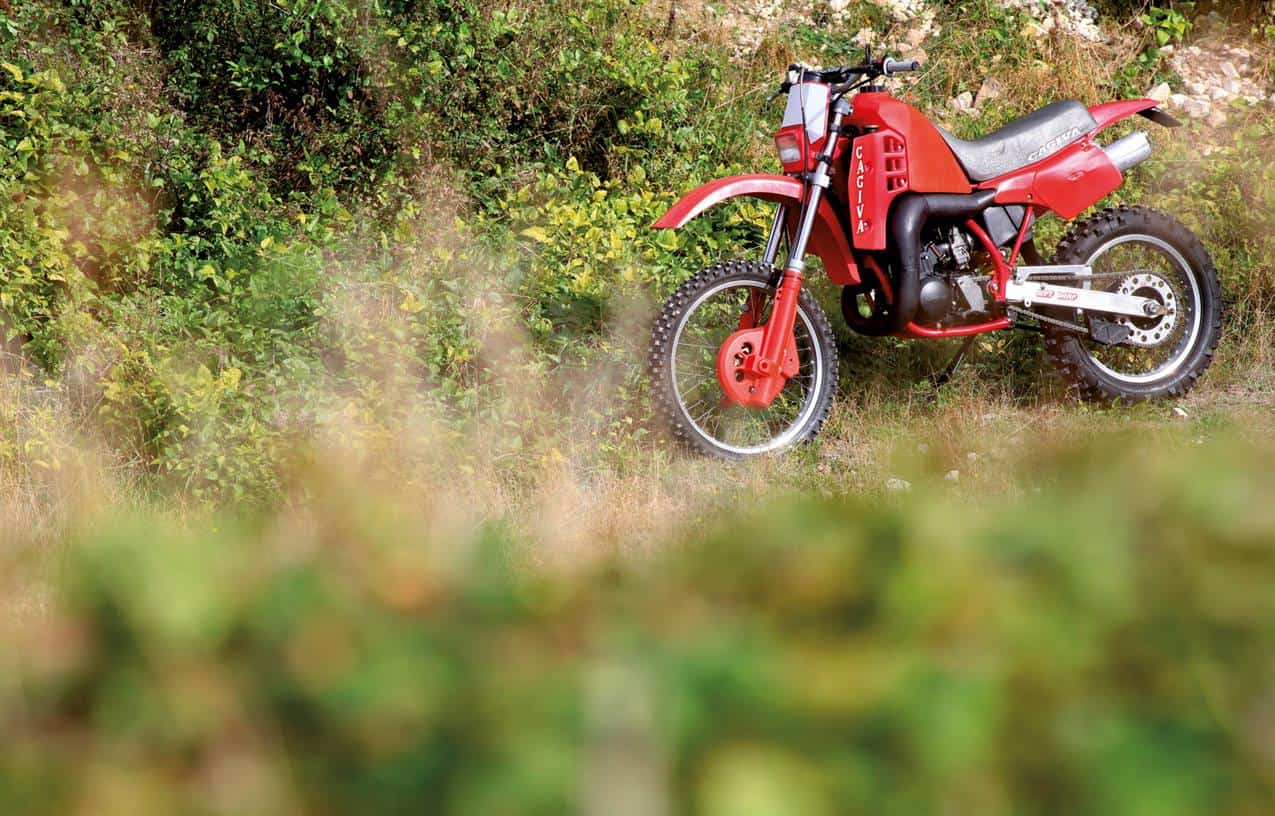

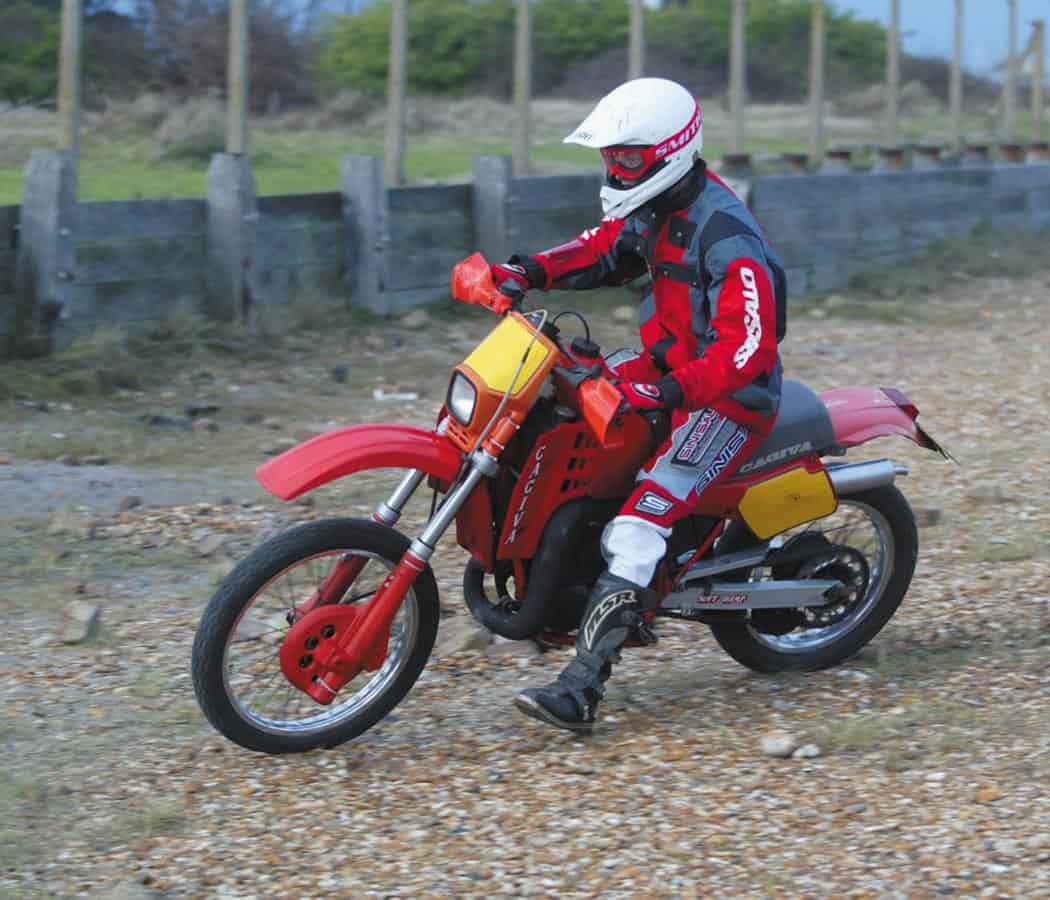
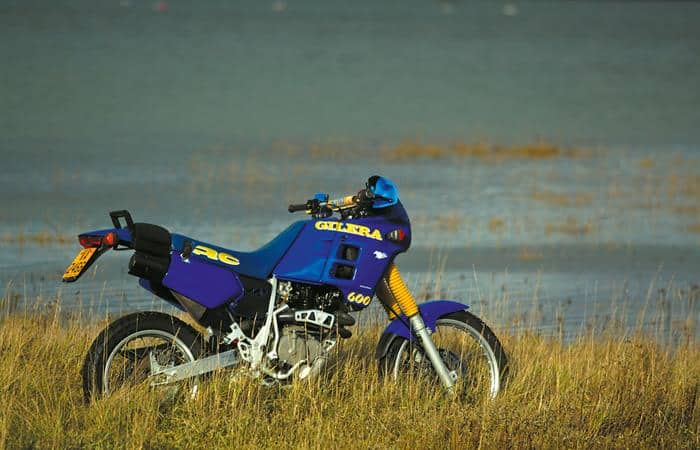
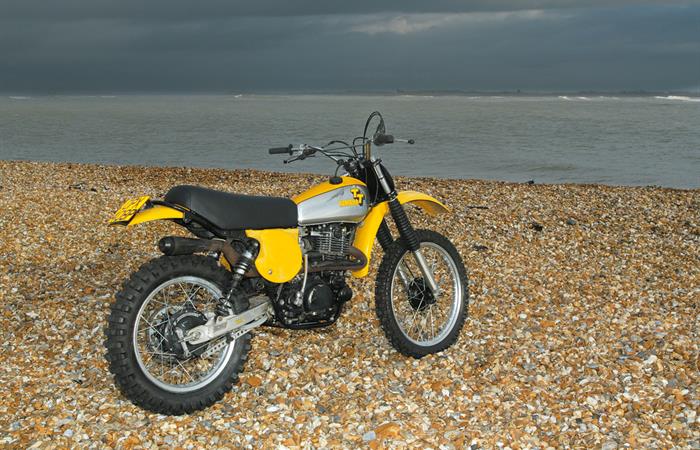
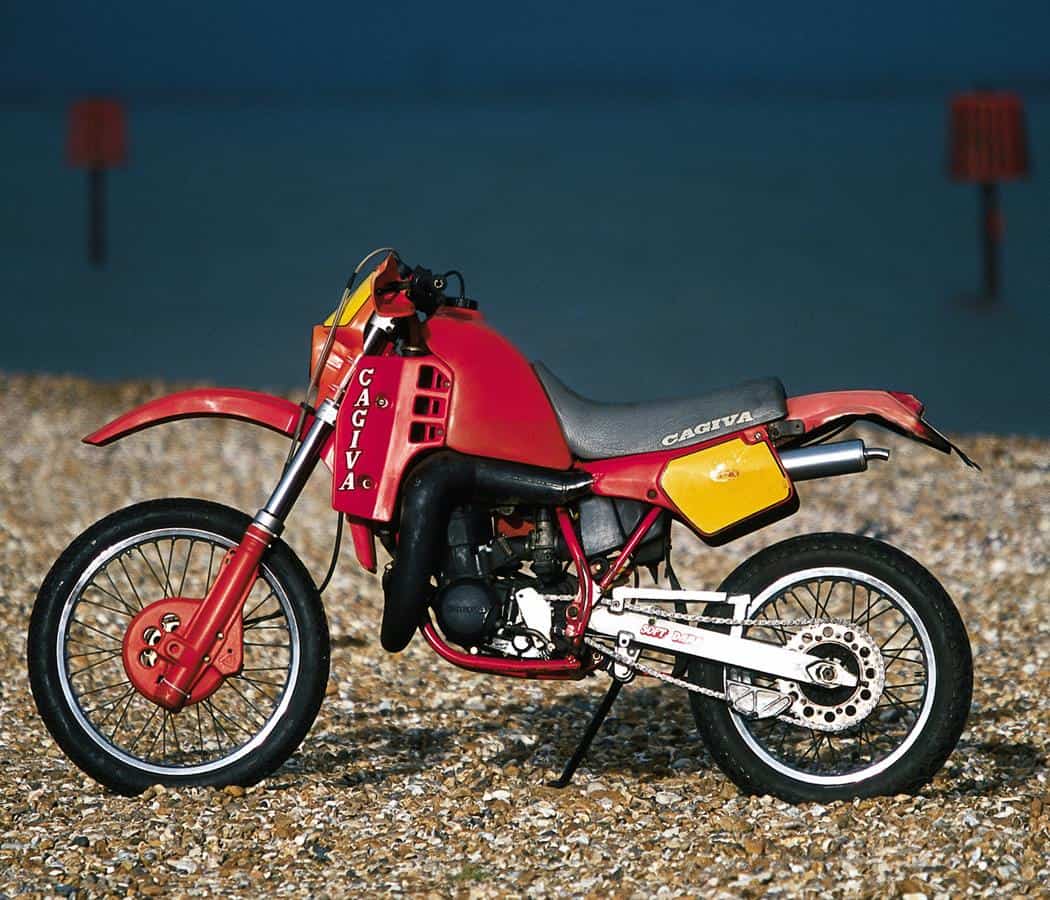
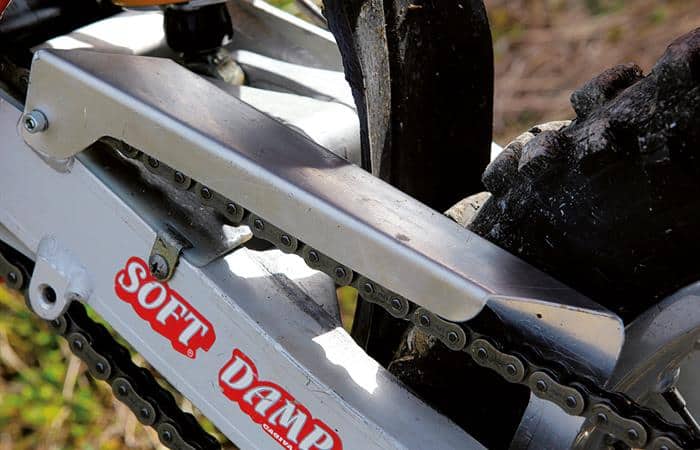
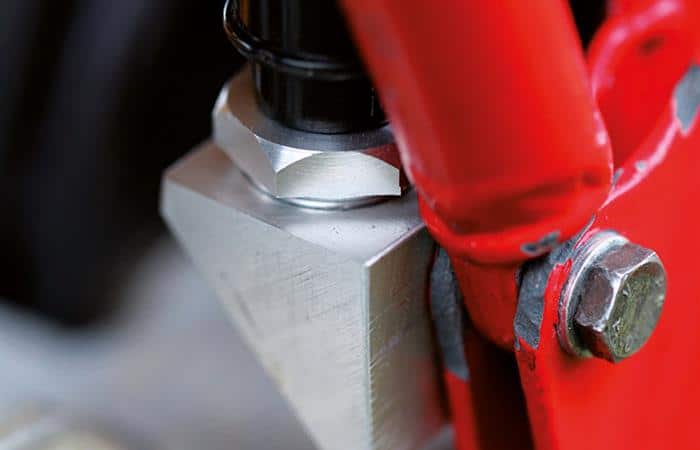

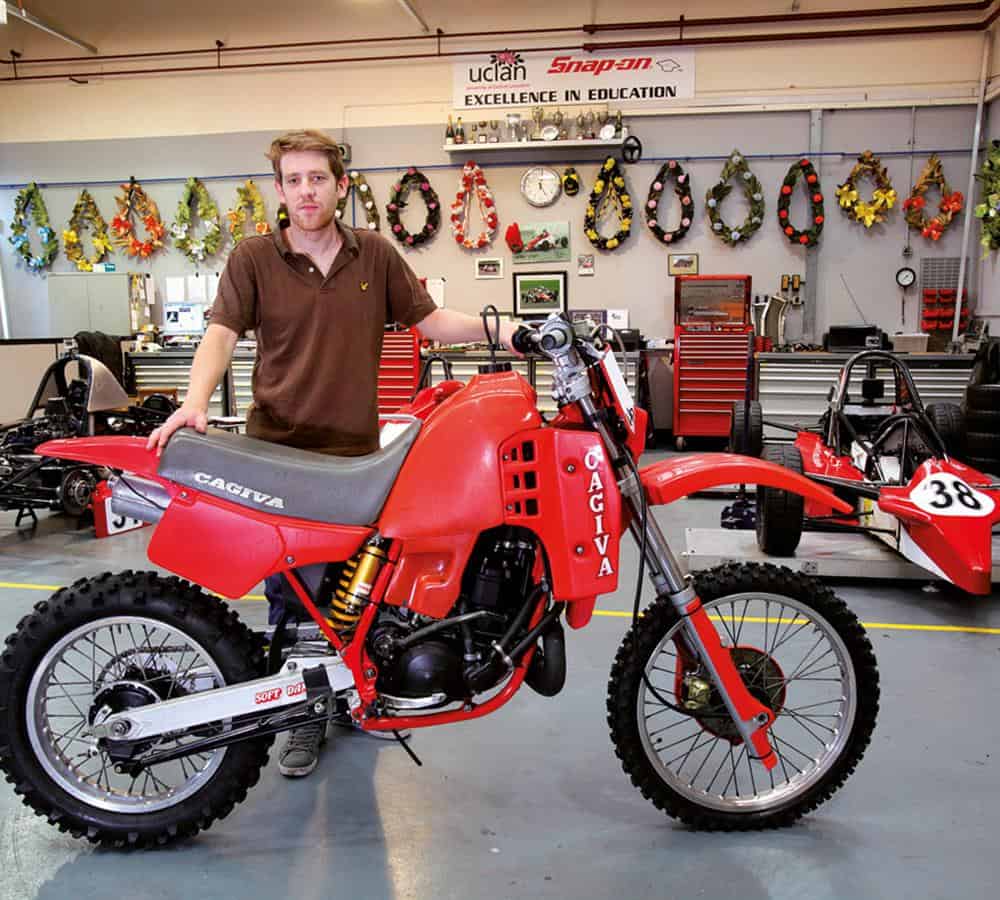
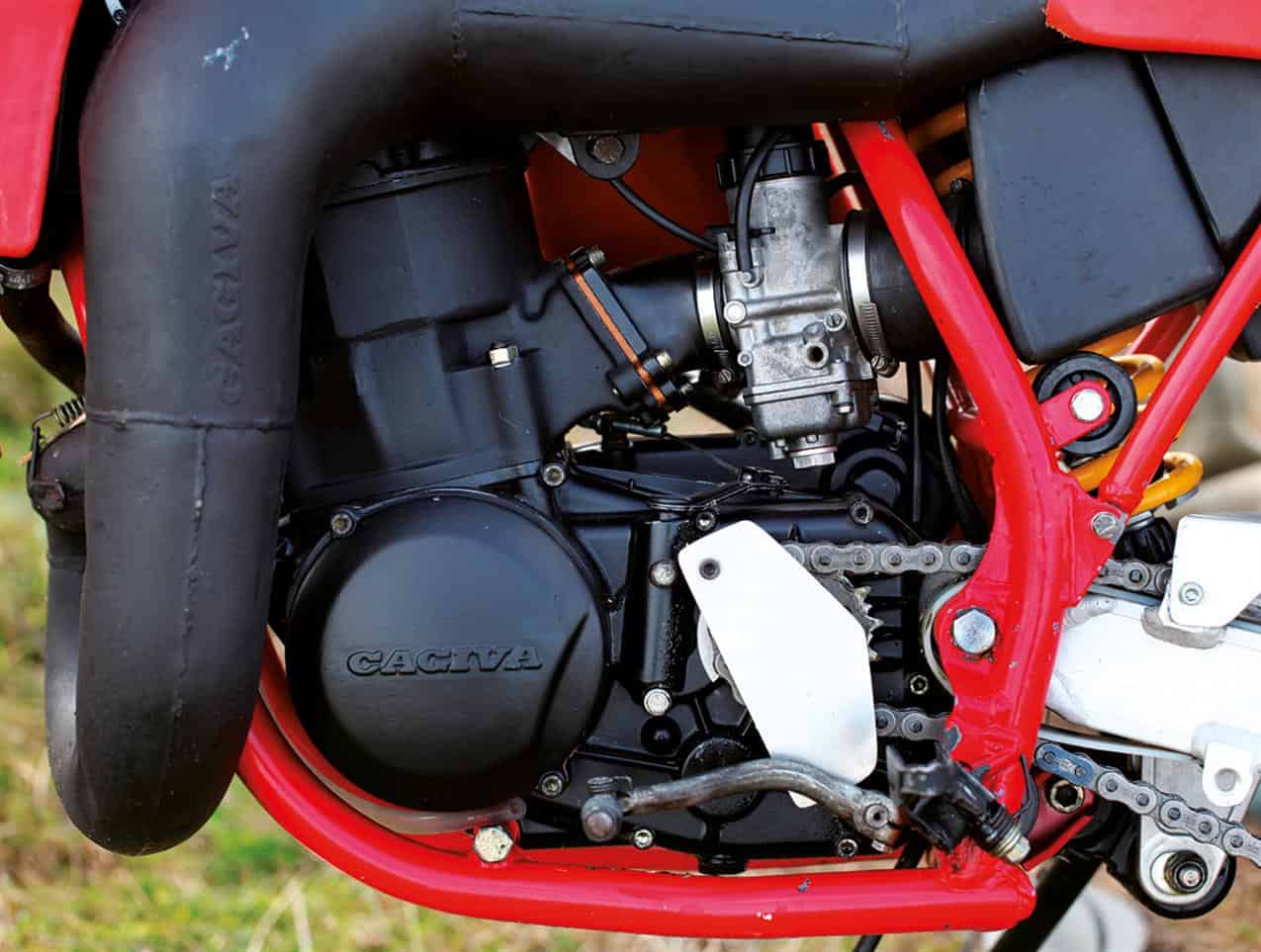
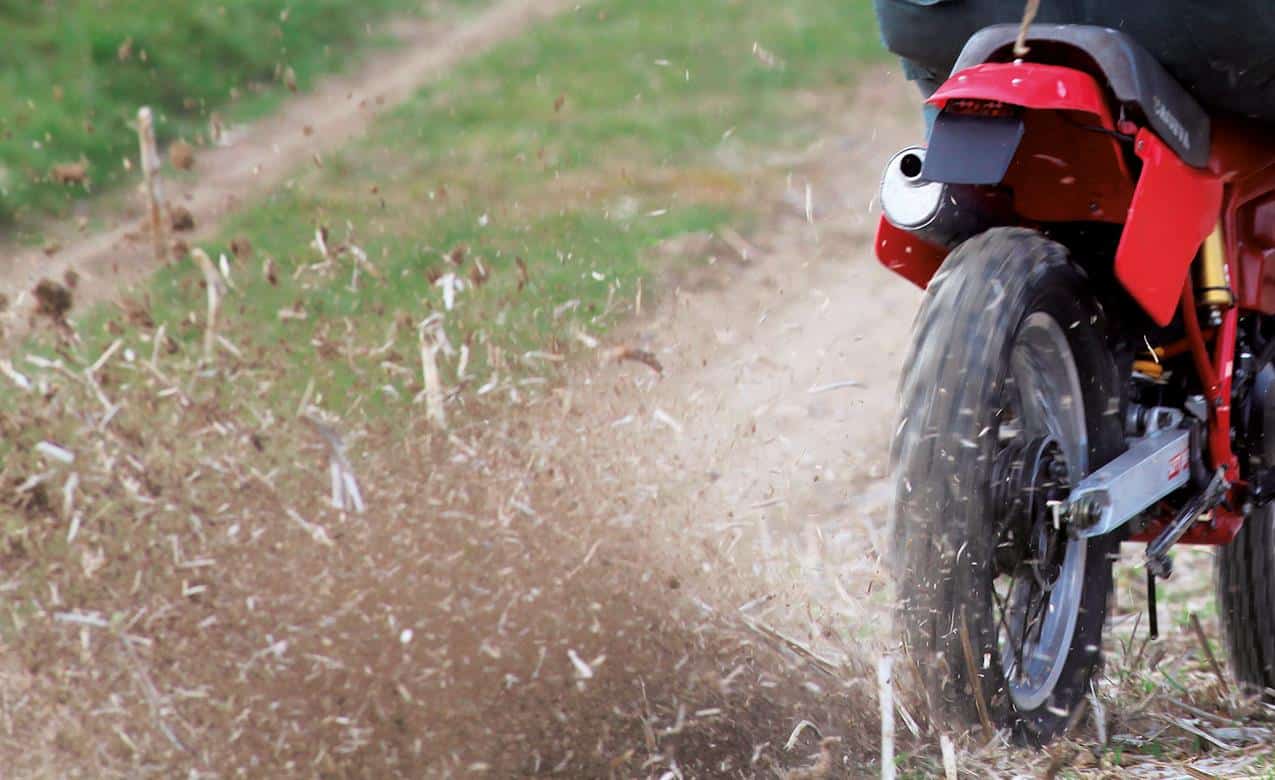
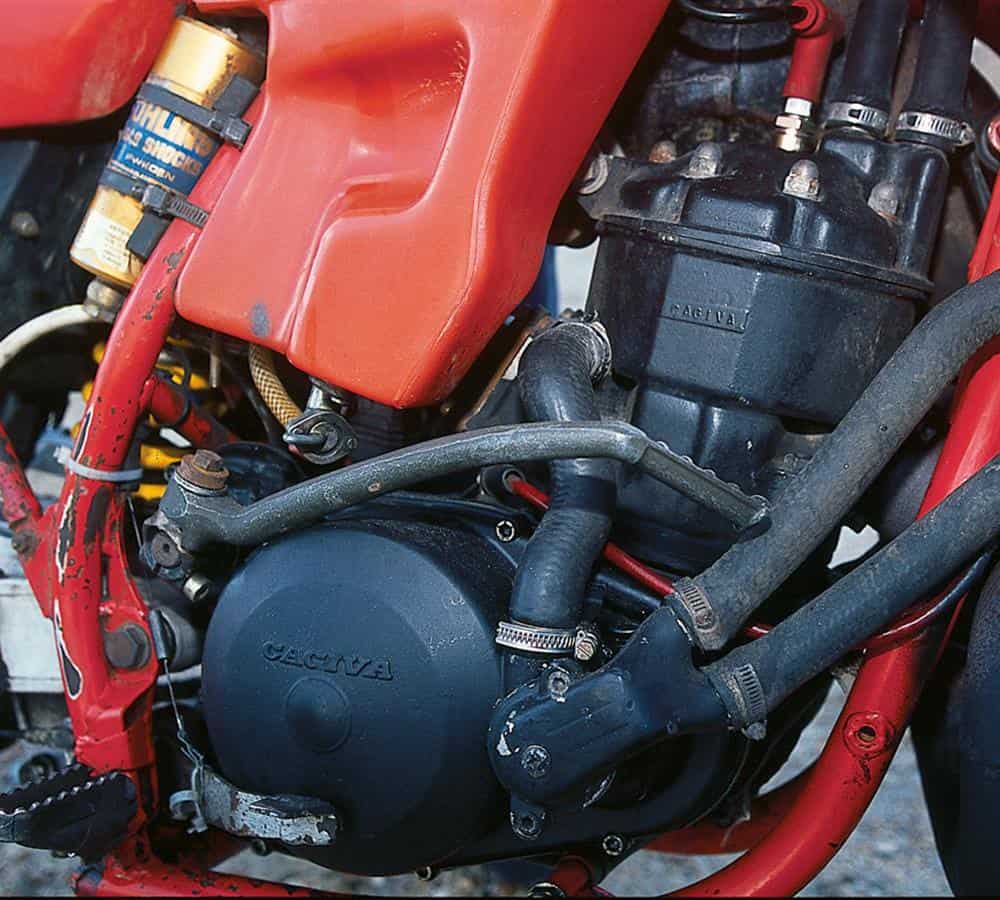

12 responses
There was a Cagiva 500 for sale when I was still in London? There may be others for sale?
I still have my original WMX 500 that Cagiva gave me back in 1985, but it is partially disassembled and has been sitting since 1987. I stumbled upon this page trying to find the bike’s weight so I can ship it to where I live now.
I loved the bike, it was even better after I had a better pipe made for it and a crazed Italian Cagiva mechanic sorted the barrel out with his Dremel tool. My only real complaint was that I broke five rear hubs on the sprocket side. Even though I had five different designs of where the bearing fit, they all came undone. One hub lasted only 15 minutes. My last race I went to the starting gate and noticed the brake stay arm had broken, so I quickly disconnected my rear brake. A few laps into the race, with only a front brake, the rear hub broke again when I landed off a jump to have the rear wheel jam and stop instantly. Back then, we used to call the seats that went up the tank a bit “Safety Seats”. Let’s just say I’m surprised I have a child today.
I’d love to buy any cagiva wmx if anyone has one
Hi Simon,
Are the Cagiva WMX 500’s still for sale? Haven’t been on this post for sometime, just revisited and seen all the new posts.
Many Thanks!
Hi Simon,
Are the Cagiva WMX 500’s still for sale? Haven’t been on this post for sometime, just revisited and seen all the new posts.
Many Thanks!
Jody
Looking for a Cagiva 500 enduro 84-86. Thanks
Hello WMX fans !
The 500 was bought by me and now lives in South Wales , alongside another part restored WMX 500.
She stills run very nicely although has not seen much action the rear brake is all sorted now
Cheers
Simon
Haha thanks Jon – I knew it was abit of a wild punt but it sounds a wild ride!
Hi Jody
I have 2 Wmx 500,s , one MX version and the DE version as per the TBM article
Both are for sale
Simon
Hello Simon, is the Cagiva 500 DE still for sale. Let me know please. Thanks
Hi,
Is the WMX500DE still for sale? It’s been a long time since the article but no harm in asking 🙂
Cheers
Jody
Simply top marks for optimism Jody! We have no idea where the beats now resides, sorry to say.
Haha thanks Jon, I knew it was abit of a wild punt for a wild ride!